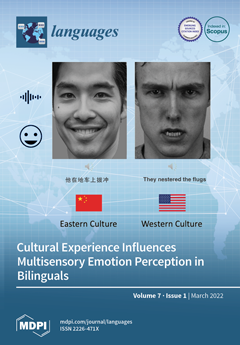Paraguayan Guarani features a pervasive pattern of aspectual polysemy whereby an underived monovalent predicate conveys both state and change of state senses, such as -
o’ysã ‘be cold/get cold.’ The language also allows the derivation of monovalent predicates from causative verbs by the
[...] Read more.
Paraguayan Guarani features a pervasive pattern of aspectual polysemy whereby an underived monovalent predicate conveys both state and change of state senses, such as -
o’ysã ‘be cold/get cold.’ The language also allows the derivation of monovalent predicates from causative verbs by the
je-/ñe- prefix, yielding two distinct classes. The first one, called Class I, comprises predicates derived from causatives without an underived intransitive counterpart, such as -
je-pe’a, from
-pe’a ‘open (tr.).’ The second class, called Class II, are predicates derived from causatives with an underived intransitive counterpart, such as -
je-jeko and -
ñe-moro’ysã, from
-jeko ‘break (tr.)’ and -
moro’ysã ‘make cold,’ which are associated with the underived intransitives -
jeka ‘break (intr.)’ and -
o’ysã ‘be cold/get cold,’ respectively. It is shown that the aspectual polysemy pattern extends to
je-/ñe-derived predicates, but that its distribution is restricted to Class I predicates. An apparent exception to this are some Class II predicates with a ‘feigned state’ interpretation, such as
-ñembotavy ‘pretend to be dumb.’ The evidence reveals, however, that these are not true states, but instead activities. Furthermore, it is argued that the
je-/ñe- predicates with this interpretation are not the product of a derivation process but are rather best analyzed as an independent construction.
Full article





